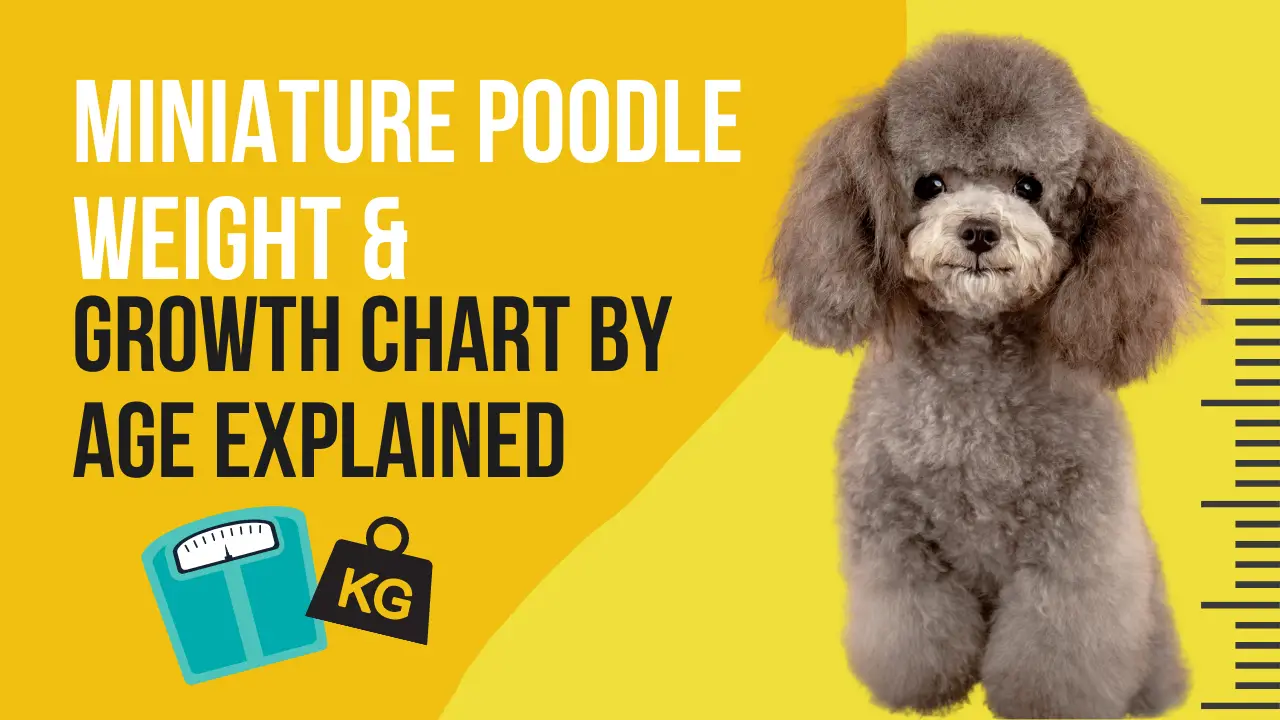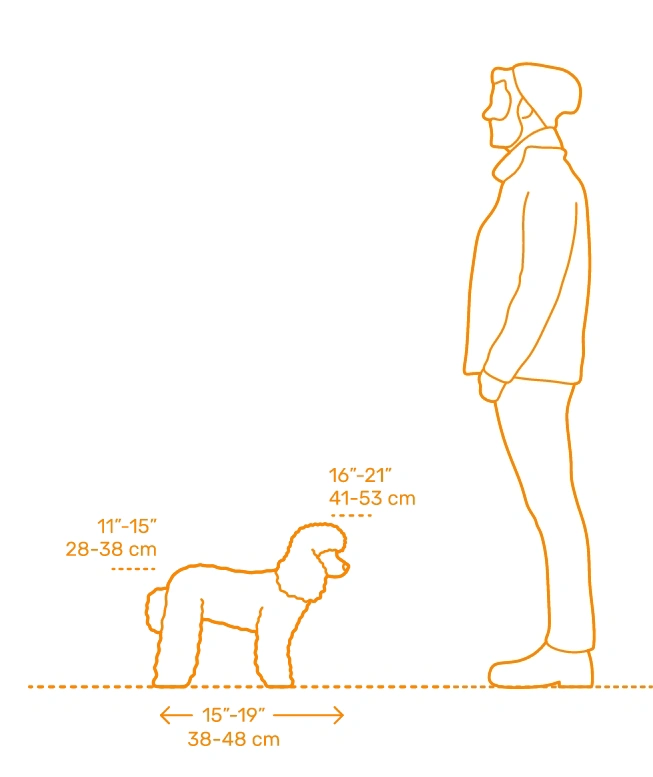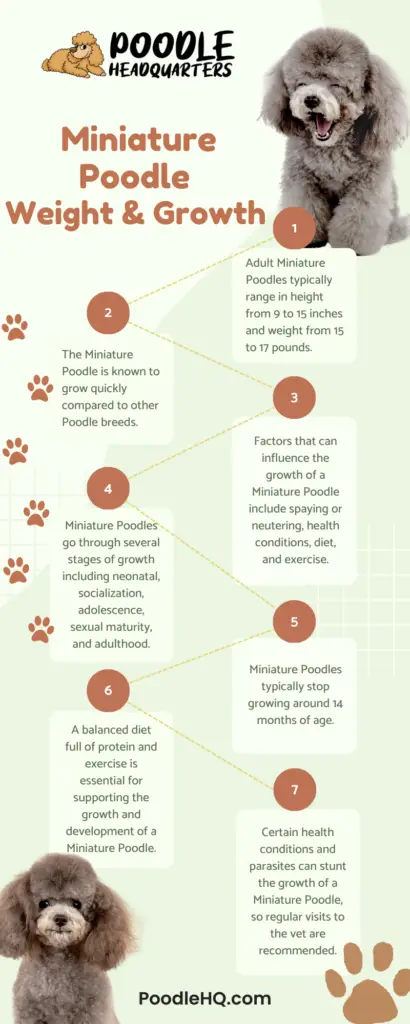Small dogs vs. large dog breeds can often be a controversial topic.

If you’re like me, you might find that you prefer one type over another, or you may simply just love both.if you choose to do this while they’re young, they will grow taller than if they got this operation when they’re an adul
One of the best things about the Poodle breed is that they come in a range of different sizes and types: the Standard, Miniature, and Toy.

Read our Smart Poodles - Smart Tricks eBook for only $2.99
Dive into a treasure trove of engaging tricks and tips designed specifically for your poodle!
I could go on all day writing about these breeds, but today I’m specifically focusing on the Miniature Poodle, the ideal breed for small dog lovers.
What Will You Learn? 👇
What is the size of a Miniature Poodle?
The American Kennel Club says that adult Miniature Poodles can be between:
- 9 to 15inches / 23 to 38cm in height
- 15 to 17lbs / 7 to 8kg in weigh
In comparison to other Poodle breeds, it’s believed that the Miniature Poodle grows the quickest.
If you plan on owning a Miniature Poodle, you should be aware of its growth patterns as a puppy and an adult. Doing this will help you look after and support their physical and mental developments, allowing them to live a healthy and long-lasting life.
Is a Miniature Poodle a small or medium-sized dog?
When it comes to owning a Miniature Poodle, don’t be deceived by the name. They’re actually classed as a medium sized dogs. While they’re not large like the Standard Poodle, they still hold a lot of qualities the Standard Poodle does and has as just much energy.

What can influence the growth of a Miniature Poodle?
As a dog owner, there are certain factors you can look out for which may influence the growth of a Miniature Poodle which are:
- Spaying or neutering
Sometimes the time period, i.e., the age you decide to spay or neuter a Miniature Poodle, might influence their growth. In particular, if you choose to do this while they’re young, they will grow taller than if they got this operation when they’re an adult. This is because the growth plates close slower, so bones grow longer.
On the contrary, if you choose to spay or neuter a Miniature Poodle between 12-24 months or later, they could be heavier. This is mainly because the adult hormones they have can cause their chest to broaden, and as a result, they can develop more muscles.
- Health conditions
There are some health conditions like parasites that can stunt a Miniature Poodle’s growth. However, this can be easily rectified if you take them to a vet and get the appropriate medication.
- Diet
A Miniature Poodle will need to be fed a balanced diet full of protein and food that’s suitable for its lifestyle. Try to avoid filler food and speak to a vet to get recommendations of the best type of food for it to eat.
- Exercise
If you’re planning on owning a Miniature Poodle, then don’t be deceived by its size. This breed has a lot of energy and needs to be taken out regularly for daily exercise. If it’s not taken out for long walks, runs, playtime, or anything else for at least 30 minutes a day, their growth could be stunted.
Stages of growth of the Miniature Poodle
Even though there is not much difference between height and weight for the different sexes of Miniature Poodles, there is a vast difference in growth rates. Once they’re born, you will find a Miniature Poodle will shoot up in height quite quickly. After a few months, they start to slow down and fill out, gaining weight and muscle mass.
To help you understand the stages of the Miniature Poodle, please find below a growth chart.
| Age in Weeks | Weight | Percentage of Adult weight |
| 8 weeks | 2-3 lbs | 15-20% |
| 12 weeks | 3-4 lbs | 25-30% |
| 16 weeks | 4-5 lbs | 35-40% |
| 20 weeks | 5-6 lbs | 45-50% |
| 24 weeks | 6-7 lbs | 55-60% |
| 28 weeks | 7-8 lbs | 65-70% |
| 32 weeks | 8-9 lbs | 75-80% |
| 36 weeks | 9-10 lbs | 85-90% |
| 40 weeks | 10-11 lbs | 90-95% |
| 48 weeks | 11-12 lbs | 95-98% |
| 52 weeks | 12-13 lbs | 98-100% |
On average, by week 16, i.e., when a Miniature Poodle is 4 months old, they should have grown around 70% in height. However, in regards to their weight, they will only have reached 40% of their adult weight at this period.
They tend to grow more quickly than they do filling out their weight. Note that if you own a Miniature Poodle, it’s also possible for their height and weight to fall outside these measurements. These are only an estimate and not every Poodle falls into these categories.

But, to know that they’re growing at a good rate and a healthy one, you must measure a Miniature Poodle regularly. To do this, you will want to measure its height by the shoulders to get the most accurate measurement. To get an accurate weight measurement, you might want to use a digital scale and place them on it.
When do Miniature Poodles stop growing?
At around 28-48 weeks of age, i.e., 7-12 months, a Miniature Poodle will stop growing tall. By this point, most of them will have reached 99% of their estimated adult height and more than 90% of their overall adult weight. Then at around 72 weeks, i.e., 18 months, will a Miniature Poodle stop growing completely as it will have reached its final adult height.
A breakdown of a Miniature Poodle puppy’s growth
If you’re planning on owning a Miniature Poodle from puppyhood, then you should have an idea of its typical growth stages. In total, there are five growth stages of a Miniature Poodle puppy which are: neonatal stage, socialization period, adolescence, sexual maturity, and adulthood. To help you understand them, let’s break them down:
Neonatal stage (Birth-3 weeks)
The neonatal stage begins as soon as a Miniature Poodle puppy is born. On average, when they’re born, they weigh around 6 ounces. During this stage, Minature Poodle puppies are dependent on their mothers for feeding and playing.
In this period, their ears and eyes begin to open slowly. Most of the time during this period, they’re sleeping and eating, and it takes some time before they start to hear and see properly. The same applies to walking also. If you happen to own a Miniature Poodle during this age group, you should closely observe and help it adapt to its surroundings.
Socialization Period (1-3 months)
During the 4-8 week period, many Miniature Poodles start to become independent from their mother. To help speed up their independence, they should be slowly introduced to other dogs and humans to stop becoming aggressive when they’re older.
At this time, they must be vaccinated first before exploring outside and meeting other people. During this growth phase, their baby teeth start to come in, they start to eat solid foods, and it’s the right time to start house training.
Adolescence (3-7months)
The teenage years of a Minature Poodle puppy are between 3-7months. During this period, they grow at a rapid rate and start to develop motor skills.
Sexual maturity (8-9months)
Once a Miniature Poodle reaches 8-9 months old, it’s thought they reach sexual maturity. By this point, most of their development will have nearly been complete. They should have a full set of adult teeth, and they start to get sexually active. This is often the ideal time to neuter or Spay a Miniature Poodle.
Adulthood (14 months and up)
Once a Miniature Poodle has reached 14 months, and upwards, they’re classed as an adult. Growth does occur at this age, but it tends to be slow. The majority of their physical and mental development will have been complete by this point.
How much should a Miniature Poodle eat a day?
A Miniature Poodle should be fed healthy meals that are free from filler food. On average, if a Miniature Poodle weighs between 15-17lbs / 6-8kg, they should be fed based on food given and its nutrient profile. Owners should check the packaging for a feeding guide. You should split this cup into 2-3 meals a day to fulfill their hunger requirements. To know the type of food to feed them, you should speak to your vet, who will look at their health issues, allergies, parent’s history, and they will advise the right brand and quantity to feed them.
| Weight (lbs) | Activity Level | Daily Calorie Needs | Daily Food Intake (cups) |
|---|---|---|---|
| 10-15 | Moderate | 300-400 | 1/2 – 3/4 |
| 15-17 | Moderate to High | 400-500 | 3/4 – 1 |
| 17-20 | High | 500-600 | 1 – 1 1/4 |
Growth related health conditions
As the Miniature Poodle is a medium breed, sometimes they can experience some health conditions that affect their growth. They are:
- Legg Perthes disease: An orthopedic disease that causes the femoral head in their hip joint to disintegrate. This disease can cause limping, pain, stiffness, and limited movement. It’s usually treated by surgery.
- Patellar luxation: This is where their knee cap can become dislocated and comes out of their femoral groove when they flex their knee. Patellar luxation can cause a Miniature Poodle a lot of pain and is often managed with pain medication or surgery.

In conclusion
If you’re planning on owning a Miniature Poodle or own one, you must keep track of its height, weight, and age. The best thing to do is to use the body condition score to determine the ideal weight.
Moreover, if you notice any differences, you can always take them to a veterinarian to see if there’s any reason for a delay in growth or any underlying health problems.
Do you have a Miniature Poodle? Let us know how often you weigh and measure their height in the comments below.
Marko is the founder and author at PoodleHQ, where he blends profound expertise with formal training in Animal Behavior and Canine Genetics. With multiple generations of poodles under his care, he’s a breed connoisseur, honored with the Canine Care Excellence Award and lauded by the International Pet Enthusiasts Association.


this is my little girl, when i buy they told me is a poddle miniature. 5 and half months old. you think she is really poodle miniature
Hi Claudia. You missed attaching the image.
Hi Marko. I purchased my dog from a store/breeder who told me she is a toy poodle, red hair. They weren’t able to give me papers but said both parents were “toy”. She is about 7/8 months older now and weighs 13lbs… seems like she is really a “miniature”???? Also i have two concerning issues…. She loves to snip at me mostly hands and loves to chew on my hands, she doesn’t really bite, not hard, she’s just playing but it’s annoying, also she has started chewing on baseboards and corners of walls. There are plenty of chew toys accessible for her….. any suggestions?
Hi Jeremy.
From what you’re mentioning, it looks like either the “breeder” didn’t know the entire background of the puppy and its parents, or they deliberately misinformed you.
When it comes to snipping and chewing, you must understand that poodles are highly energetic dogs, and they need to be exercised regularly and in sufficient quantity. That kind of behavior needs to be corrected while the dog it’s still in its puppyhood. You can try longer/more challenging exercises like playing fetch, running, or other fun games, and also try engaging her to play with her chew toys as it’s a great bonding way, and she’ll learn to associate the toys with playtime.
One more thing that helped me is reading these two books by Cesar:
Looking forward to hearing an update from you 🙂
Looking forward to getting our Munja;) [Lightening] in a few more weeks. He is a red miniature poodles born on 4 SEP. He is about 5 hours away and I’m curious if you think we should go to pick him up or allow a reputable puppy transporter to deliver him to us. I’ve been reading that they need a calm entry so taking my two boys to pick him up as a family was my thought, but then maybe it would be too much excitement. Thts? Also is there much of a difference in your opinion between picking him up/having him delivered at exactly eight weeks or nine? Thanks in advance for your feedback.
Hi Lori
The day you’re getting your puppy is an unforgettable day for your family and the pup. Puppies by nature, are not very calm, so it won’t matter much if you’re getting him with a special transport or driving yourself.
I bought what I thought was a toy poodle at 8 weeks. He was big for his age quickly so I had a DNA test done. He is definitely 100% poodle. 95% toy & miniature, 5% standard. He is 25 weeks and weighs 15 1/2 lbs. How much longer will my little guy grow!? Your thoughts on large he may grow? He is not fat and very healthy
You have a Moyen (medium) poodle not Miniature.
Hi, I had my miniature poodle weighed yesterday at the vets and he is 8.9kg at 10 months old. Is this correct as they say miniature poodles adult weight is between 5-10kg and he is only 10 months old yet?
Hi Raj,
Thanks for your question. The weight of 8.9kg (19.6lbs) at 10 months old for your miniature poodle actually seems to be on the high end with what is typical for the breed at this age.
While the general adult weight range for miniature poodles given by breed standards is 5-10kg (11-22lbs), individual dogs will vary and can certainly fall at the higher end of that range without being considered overweight.
Poodles are also known to fill out slower than other breeds, continuing to gain weight and muscle mass well into their first 1-2 years as they finish developing and growing into adulthood. At only 10 months, your poodle still has time left in that crucial growing period.
As long as your vet gives the thumbs up that your poodle looks healthy and is developing properly, I wouldn’t be concerned about his current weight at all. Keep providing quality nutrition and exercise suited to his needs. Chances are he will stabilize right around 10kg full grown.
Let me know if you have any other questions!